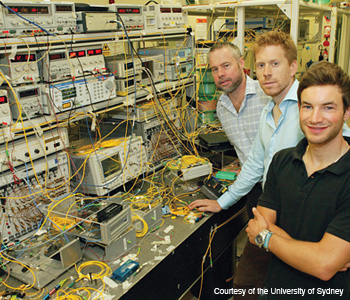Feature
Breaking the Tbit/s Barrier: Higher Bandwidth Optical Processing
The growing demand for broadband communications has inspired many approaches to increasing capacity. Our recent work shows that combining linear and nonlinear optical signal processing can overcome some of the challenges faced by high-symbol rate signals.
 Eggleton (left), Schröder and Paquot in the CUDOS Tbit/s lab at the University of Sydney.
Eggleton (left), Schröder and Paquot in the CUDOS Tbit/s lab at the University of Sydney.
Courtesy of the University of Sydney
Our ability to send large amounts of data through a single optical fiber has revolutionized the way we communicate. Ever since Charles Kao predicted that light could propagate through a single mode fiber at a total loss of less than 20 dB/km, optical fiber communications has taken on an increasingly important role in our society. Optical fibers are now ubiquitous, and they form the backbone of all modern telecommunication networks. It’s no wonder that Kao was awarded a portion of the 2009 Nobel Prize in physics for “groundbreaking achievements concerning the transmission of light in fibers for optical communication.”
…Log in or become a member to view the full text of this article.
This article may be available for purchase via the search at Optica Publishing Group.
Optica Members get the full text of Optics & Photonics News, plus a variety of other member benefits.
